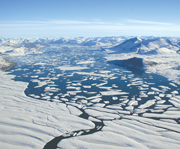Dr. Luke Copland, director of the University’s Laboratory for Cryospheric Research, and a team of scientists recently reported the separating of the 50 km2 Markham Ice Shelf from Ellesmere Island. Other large losses also occurred this summer from the Serson Ice Shelf, which lost 60 per cent (122 km2) of its area.

These ice masses that once formed part of Ellesmere Island are now adrift in the Arctic Ocean. This follows the calving of the Ward Hunt Ice Shelf in the Canadian Arctic, in July. The total ice loss for the summer is 214 km2, which equates to more than three times the size of Manhattan Island and is almost a quarter of all remaining Canadian ice shelves.
Researchers believe that the cause of the changes to the Ellesmere ice shelves is the result of shifting environmental conditions that have kept the ice shelves in balance for more than 4,000 years. It is also believed that the changes are irreversible.
“It would be difficult to say that one single event such as this is the result of a warming climate,” notes Dr. Copland. “However if you take these changes and examine them in a wider perspective, it is clear that this is not an isolated event and that the Arctic is in fact changing.”
Dr. Copland and his graduate students will return to the Arctic in the spring to continue their research. Until that time, they will monitor the region for changes through satellite images.